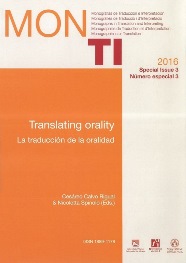Personal deixis in Spanish-Italian simultaneous interpretation
##plugins.themes.bootstrap3.article.main##
Resum
Descàrregues
##plugins.themes.bootstrap3.article.details##
La propietat intel·lectual dels articles pertany als autors i els drets d'edició i publicació, a la revista. Els articles publicats en la revista podran ser utilitzats lliurement per a propòsits educatius i científics, sempre que se'n faça una correcta citació. Qualsevol ús comercial és expressament penat per la llei.
Referències
Barrenechea, Ana María. (1979) “Operadores pragmáticos de actitud oracional. Los adverbios en -mente y otros signos”. En: Barrenechea, Ana María et al. (eds.) Estudios lingüísticos y dialectológicos: Temas hispánicos. Buenos Aires: Hachette, pp. 39-59.
Bazzanella, Carla. (1994) Le facce del parlare. Florencia: La Nuova Italia.
Bühler, Karl. (1934) Sprachteorie. Die Darstellungfunktion der Sprache. Stuttgart: Gustav Fischer. Citado por la traducción italiana de Serena Cattaruzza Derossi: Teoria del linguaggio. La funzione rappresentativa del linguaggio. Roma: Armando, 1983.
Carrera Díaz, Manuel. (1997) Grammatica spagnola. Bari/Roma: Laterza.
Eguren, Luis. (1999) “Pronombres y adverbios demostrativos”. En: Bosque, Ignacio & Violeta Demonte (eds.) Gramática descriptiva de la lengua española. Madrid: Espasa-Calpe, vol. 1, pp. 1275-1316.
Fillmore, Charles. (1975) Santa Cruz Lectures on Deixis, 1971. Bloomington: Indiana University Linguistic Club.
Haverkate. Hank. (1998) “Estrategias de cortesía. Análisis intercultural.” En: Celis, Ángela & José Ramón Heredia (eds.) Actas del VII Congreso de ASELE. Lengua y cultura en la enseñanza de español a extranjeros. Cuenca: Ediciones de la Universidad de Castilla-La Mancha, pp. 45-57.
Jakobson, Roman. (1957) “Shifters, verbal categories, and the Russian verb”. En: Waugh, L. & M. Monville-Burston (eds.) 1990. On Language: Roman Jakobson. Cambridge (Mass.): Harvard University Russian Language Project, pp. 386-392.
Jespersen, Otto. (1922) Language. Its Nature, Development and Origin. London: George Allen & Unwin.
Levinson, Stephen C. (1983) Pragmatics. Cambridge: Cambridge University Press.
Levinson, Stephen C. (2004) “Deixis”. En: Horn, Laurence & Gregory Ward (eds.). The Handbook of Pragmatics. Oxford: Blackwell, pp. 97-121.
Lyons, John. (1977) Semantics. Vol. 2. Cambridge: Cambridge University Press. Citado por la traducción española: Semántica. Barcelona: Teide, 1980.
Rommetveit, Ragnar. (1968) Words, meanings and messages. New York: Academic Press.
Vanelli, Laura & Lorenzo Renzi. (2001) “La deissi”. En: Renzi, Lorenzo; Giampaolo Salvi & Anna Cardinaletti (eds.) Grande grammatica italiana di consultazione. Bolonia: Il Mulino, vol. 3, pp. 261-350.
Van Dijk, Teun. (2008) Discurso y poder. Barcelona: Gedisa.
Van Dijk, Teun. (2003) Racismo y discurso de las élites. Barcelona: Gedisa.


